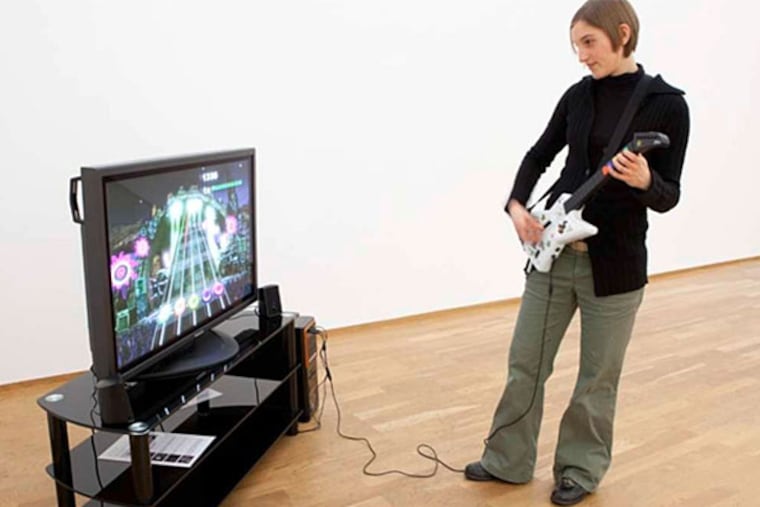Galleries: Ready, set . . . play!
See "Free Play" when you're in a playful mood. The first time I went to this exhibition, a project of Independent Curators International (ICI) making its first appearance at the Arcadia University Art Gallery before moving on, I wasn't prepared for artworks that demanded my participation. I realized I'd have to return with a more carefree frame of mind and more expendable time.

See "Free Play" when you're in a playful mood. The first time I went to this exhibition, a project of Independent Curators International (ICI) making its first appearance at the Arcadia University Art Gallery before moving on, I wasn't prepared for artworks that demanded my participation. I realized I'd have to return with a more carefree frame of mind and more expendable time.
The second visit was the charm. I played Ping-Pong with an enthusiastic gallery visitor, tossed dice on a game board to determine my future, and went up and down on a seesaw. Had no one else been in the gallery, I might have picked up an electric guitar. It's frighteningly easy to tap into your inner adolescent (I also played video games). "Free Play" is a reminder that art and fun have never been mutually exclusive.
In her essay for the show, Melissa E. Feldman, its curator, begins with a pertinent quotation from the French Marxist theorist Guy Debord: "No vital periods ever began from a theory. What's first is a game, a struggle, a journey."
Feldman cites the surrealists and dadaists, who used drawing as a gateway to the psyche in the game Exquisite Corpse; the activities of the avant-garde Fluxus group of the 1960s and '70s, specifically the portable "game boxes" that were mailed to the group's global happenings; and the New Games Foundation's subversion of corporate culture through its organization of public games in city parks.
The art of Marcel Duchamp, who was also a chess master, is perhaps the perfect test of Debord's theory-debunking theory.
"His every creative move had his chess partner in mind: you, the viewer," Feldman writes, referring to Duchamp's 1957 essay "The Creative Act," in which the artist stated that a work of art is completed by the viewer.
Like Duchamp's ready-mades, most of the works by the 14 artists in Feldman's show do not read as "art." There is Jennie Shanker's aforementioned functional seesaw, Shoot the Moon, including a game for two in which a ball is maneuvered through chutes by flippers with control bars at both ends of the plank. The electric guitar belongs to Cory Arcangel's Composition #7, a video game operated by buttons on the guitar's neck, Guitar Hero-style; Jason Rohrer's video game, Passage, shown on an iPad, invites the player to move a male and female character into a rewarding relationship (players win points!) by pressing an analog stick to maneuver the characters.
Allan McCollum and Matt Mullican - the more "senior" of the show's artists, along with Yoko Ono - collaborated on Your Fate, a wood game board with felt inserts in which a player picks up dice imprinted with graphic symbols commonly used by Mullican in his art, and tosses them on the board. Images facing up tell you your destiny; their meanings are interpreted in a guidebook next to the board. Ono's contribution is a recent iteration one of her Fluxus works from 1966, All White Chess Set, an all-white chessboard and pieces, meant to symbolize peace and the futility of war.
Charles and Ray Eames' House of Cards, the game in which children (and adults) build "houses" with a deck of cards printed with colorful photos of domestic objects, would have made a nice fit with Feldman's show.
One of the works most expressive of Feldman's thesis is David Shrigley's darkly humorous Your Parents, You, Your Wee Sister, and the Social Services. Mounted on the wall are two Ping-Pong paddles, one regular-size and the other enormous, with the words "Your Parents" and the other with "The Social Services" drawn on them respectively with markers. In between, on a shelf, are two Ping-Pong balls on which Shrigley has drawn (also with markers), "You" and "Your Wee Sister." A regulation-size Ping-Pong table allows you to hit these balls over a net. Using a minimum of objects, materials, and language, Shrigley hits every note of Feldman's theme.
"Free Play" also includes works by Patrick Bernier and Olive Martin, Ruth Catlow, Ryan Gander, Paul Noble, Pedro Reyes, and Erik Svedang.
All over now
In some ways, the colorful photographic prints that make up Sara Cwynar's series "Flat Death" at the University of the Arts' Rosenwald-Wolf Gallery are the direct descendants of the Eames' cards and Giuseppe Arcimboldo's 16th-century portraits composed of fruits, vegetables, and other edibles. Like the former, they allude to design and the archive; like the latter, they're eccentric and witty.
But Cwynar's compositions of vintage books and magazines and cast-off consumer items displayed to mimic flower arrangements aren't the celebratory images they initially appear to be. They're about objects' obsolescence and their inevitable descent into kitsch; they suggest hoarding. Her careful rephotographing of magazine and book covers, for example, illuminates every mark of use. Her colors are those of the Kodachrome slide circa the late 1950s. Pool balls, birthday candles, and hair curlers are grimy with age.
Still, it's clear Cwynar has an affection for her flea-market finds. Her works are an eloquent elegy to their formerly useful lives.